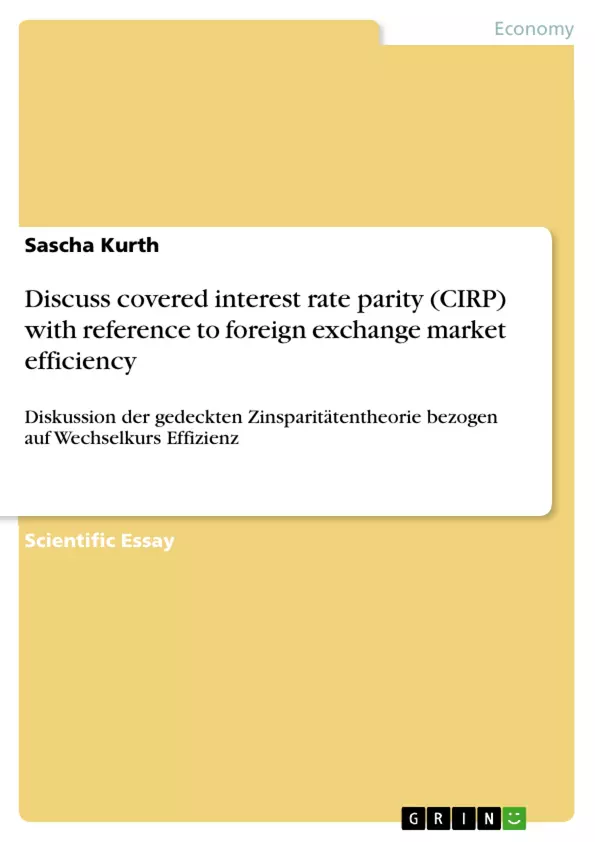Die Arbeit untersucht und erläutert die verschiedenen wissenschaftlichen Ergebnisse von renommierten Untersuchungen. The covert interest rate parity is a well-established theory model, which holds not 100%, but the principle hold nearly for most of the time in highly developed countries. The CIRP theory cares for more efficient exchange markets. However, in unstable or crisis situations the CIRP is more susceptible, it is also in developing countries with factors such as political risk, credit risk or the lack of information. Then the CIRP could not hold, this means the exchange markets can be inefficient, for reasons like a lack of information, the markets can be still efficient because they are above risks and have been incorporated, Keynes assumes in his original theory that deviations of 0.5% percent for investors due to rate adjustments during trading and transaction costs, margin becomes smaller and smaller during the time at last due to the information technology and the associated ever-faster trade opportunities and reduces transaction costs ensure more that the CIRP holds better. However the information technology just reduces the deviations, but do not influence factors like default risks or opportunity costs.
Inhaltsverzeichnis (Table of Contents)
- Introduction
- Interest parity theory
- Market efficiency regarding to CIRP
- Covered interest rate parity
- Differences between CIRP and UIRP
- Composition of the CIRP
- Discussion
- Transaction costs
- Economical Situation
- Development of the countries
- Taxes
- Opportunity costs
- Other reasons for deviation
- Summary regarding to market efficiency
- Development of the efficiency
- Conclusion
Zielsetzung und Themenschwerpunkte (Objectives and Key Themes)
This essay aims to examine the covered interest rate parity (CIRP) in relation to foreign market efficiency. The essay explores the findings of scientific analyses and the impact of new information technology to explain reasons for different results. The objective is to understand when and how far the CIRP holds and what this means for market efficiency.
- The role of the covered interest rate parity (CIRP) in understanding foreign exchange market efficiency.
- The impact of transaction costs and economic factors on the CIRP.
- The relationship between the CIRP and arbitrage opportunities.
- The implications of market efficiency for investor behavior and exchange rate movements.
- The development of market efficiency in the context of technological advancements.
Zusammenfassung der Kapitel (Chapter Summaries)
- Introduction: This chapter introduces the interest parity theory, outlining its origins and key concepts. It discusses how investors seek the best returns and the role of capital movements in influencing exchange rates. The chapter also discusses the concept of market efficiency and its relevance to the CIRP, explaining how it relates to arbitrage opportunities and information dissemination.
- Covered Interest Rate Parity: This chapter distinguishes between the covered interest rate parity (CIRP) and the uncovered interest rate parity (UIRP). It explains the key components of the CIRP, highlighting the relationship between forward rates, interest rates, and spot exchange rates. The chapter emphasizes that the CIRP assumes perfect capital mobility, substitutability of securities, and risk neutrality among investors.
- Discussion: This chapter delves into factors that influence the results of CIRP analysis. Transaction costs are highlighted as a significant factor contributing to deviations from the CIRP. The impact of economic situations, including periods of market turbulence, on the CIRP is also discussed. This chapter explores the concept of transaction cost bandwidth and its role in accounting for deviations.
Schlüsselwörter (Keywords)
The primary keywords and focus topics of the text include covered interest rate parity (CIRP), uncovered interest rate parity (UIRP), foreign exchange market efficiency, transaction costs, arbitrage opportunities, capital mobility, substitutability of securities, risk neutrality, and market turbulence.
- Arbeit zitieren
- Sascha Kurth (Autor:in), 2010, Discuss covered interest rate parity (CIRP) with reference to foreign exchange market efficiency, München, GRIN Verlag, https://www.grin.com/document/165493



